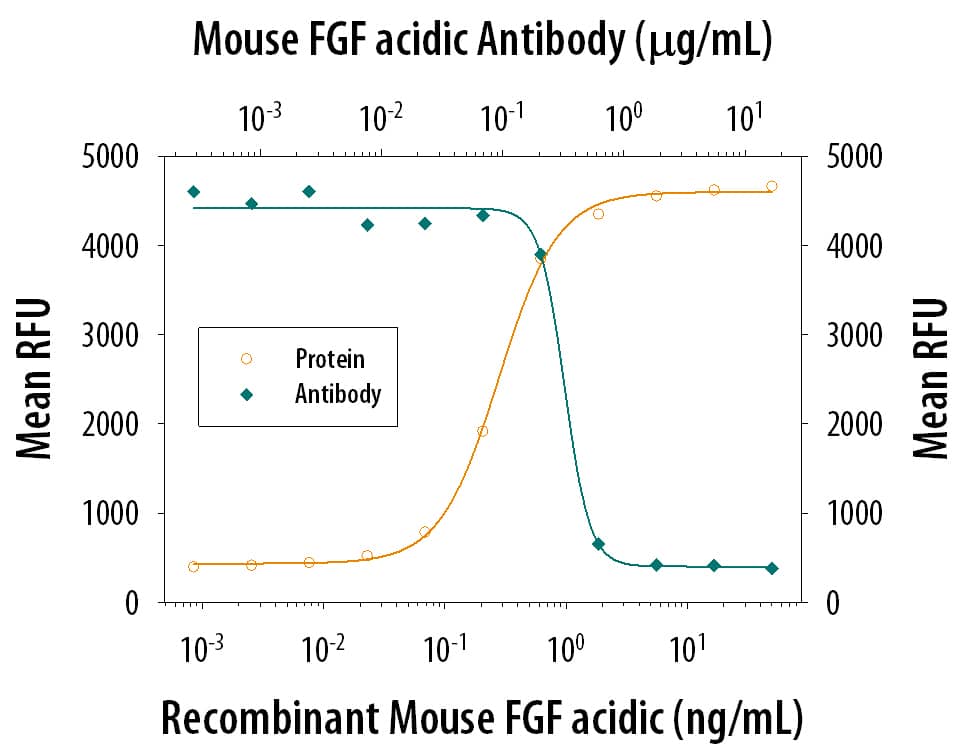Mouse FGF acidic/FGF1 Antibody
R&D Systems, part of Bio-Techne | Catalog # AF4686

Key Product Details
Species Reactivity
Validated:
Cited:
Applications
Validated:
Cited:
Label
Antibody Source
Product Specifications
Immunogen
Phe16-Asp155
Accession # NP_034327
Specificity
Clonality
Host
Isotype
Endotoxin Level
Scientific Data Images for Mouse FGF acidic/FGF1 Antibody
Detection of Mouse FGF acidic/FGF1 by Western Blot.
Western blot shows lysates of mouse heart tissue and mouse kidney tissue. PVDF membrane was probed with 2 µg/mL of Sheep Anti-Mouse FGF acidic/FGF1 Antigen Affinity-purified Polyclonal Antibody (Catalog # AF4686) followed by HRP-conjugated Anti-Sheep IgG Secondary Antibody (Catalog # HAF016). A specific band was detected for FGF acidic/FGF1 at approximately 18 kDa (as indicated). This experiment was conducted under reducing conditions and using Immunoblot Buffer Group 1.Cell Proliferation Induced by FGF acidic/FGF1 and Neutralization by Mouse FGF acidic/FGF1 Antibody.
Recombinant Mouse FGF acidic/FGF1 (Catalog # 4686-FA) induces proliferation in the NR6R-3T3 mouse fibroblast cell line in a dose-dependent manner (orange line). Proliferation elicited by Recombinant Mouse FGF acidic/FGF1 (1 ng/mL) is neutralized (green line) by increasing concentrations of Sheep Anti-Mouse FGF acidic/FGF1 Antigen Affinity-purified Poly-clonal Antibody (Catalog # AF4686). The ND50 is typically 0.1-0.6 µg/mL.Applications for Mouse FGF acidic/FGF1 Antibody
Western Blot
Sample: Mouse heart tissue and mouse kidney tissue
Neutralization
Reviewed Applications
Read 1 review rated 4 using AF4686 in the following applications:
Formulation, Preparation, and Storage
Purification
Reconstitution
Formulation
Shipping
Stability & Storage
- 12 months from date of receipt, -20 to -70 °C as supplied.
- 1 month, 2 to 8 °C under sterile conditions after reconstitution.
- 6 months, -20 to -70 °C under sterile conditions after reconstitution.
Background: FGF acidic/FGF1
FGF acidic, also known as FGF1, ECGF, and HBGF-1, is a 17 kDa nonglycosylated member of the FGF family of mitogenic peptides. FGF acidic, which is produced by multiple cell types, stimulates the proliferation of all cells of mesodermal origin and many cells of neuroectodermal, ectodermal, and endodermal origin. It plays a number of roles in development, regeneration, and angiogenesis (1-3). Mouse FGF acidic shares 52% amino acid (aa) sequence identity with FGF basic and 15%-35% with other mouse FGFs. It shares 91%, 96%, 94%, and 100% aa sequence identity with bovine, human, porcine, and rat FGF acidic, respectively, and exhibits considerable species crossreactivity. During its nonclassical secretion, FGF acidic associates with S100A13, copper ions, and the C2A domain of synaptotagmin 1 (4). The secreted FGF acidic is stored in complex with extracellular heparan sulfate (5). The ability of heparan sulfate to bind FGF acidic is determined by its pattern of sulfation, and alterations in this pattern during embryogenesis thereby regulating FGF acidic bioactivity (6). The association of FGF acidic with heparan sulfate is a prerequisite for its subsequent interaction with FGF receptors (7, 8). Ligation triggers receptor dimerization, transphosphorylation, and internalization of receptor/FGF complexes (9). Internalized FGF acidic can translocate to the cytosol with the assistance of Hsp90 and then migrate to the nucleus by means of its two nuclear localization signals (10-12). The phosphorylation of FGF acidic by nuclear PKC delta triggers its active export to the cytosol where it is dephosphorylated and degraded (13, 14). Intracellular FGF acidic functions as a survival factor by inhibiting p53 activity and proapoptotic signaling (15).
References
- Madiai, F. et al. (1996) Gene 179:231.
- Galzie, Z. et al. (1997) Biochem. Cell Biol. 75:669.
- Presta, M. et al. (2005) Cytokine Growth Factor Rev. 16:159.
- Rajalingam, D. et al. (2007) Biochemistry 46:9225.
- Guerrini, M. et al. (2007) Curr. Pharm. Des. 13:2045.
- Allen, B.L. and A.C. Rapraeger (2003) J. Cell Biol. 163:637.
- Robinson, C.J. et al. (2005) J. Biol. Chem. 280:42274.
- Mohammadi, M. et al. (2005) Cytokine Growth Factor Rev. 16:107.
- Wiedlocha, A. and V. Sorensen (2004) Curr. Top. Microbiol. Immunol. 286:45.
- Wesche, J. et al. (2006) J. Biol. Chem. 281:11405.
- Imamura, T. et al. (1990) Science 249:1567.
- Wesche, J. et al. (2005) Biochemistry 44:6071.
- Wiedlocha, A. et al. (2005) Mol. Biol. Cell 16:794.
- Nilsen, T. et al. (2007) J. Biol. Chem. 282:26245.
- Bouleau, S. et al. (2005) Oncogene 24:7839.
Long Name
Alternate Names
Gene Symbol
UniProt
Additional FGF acidic/FGF1 Products
Product Documents for Mouse FGF acidic/FGF1 Antibody
Product Specific Notices for Mouse FGF acidic/FGF1 Antibody
For research use only

